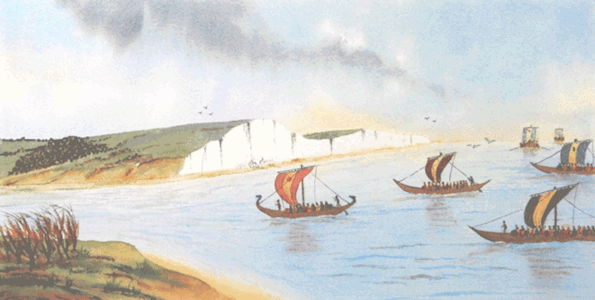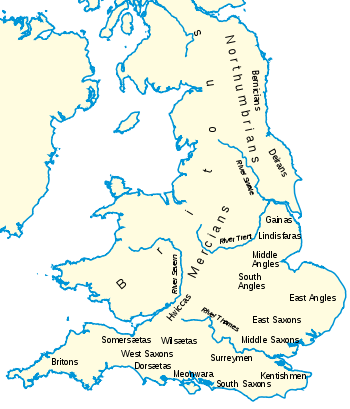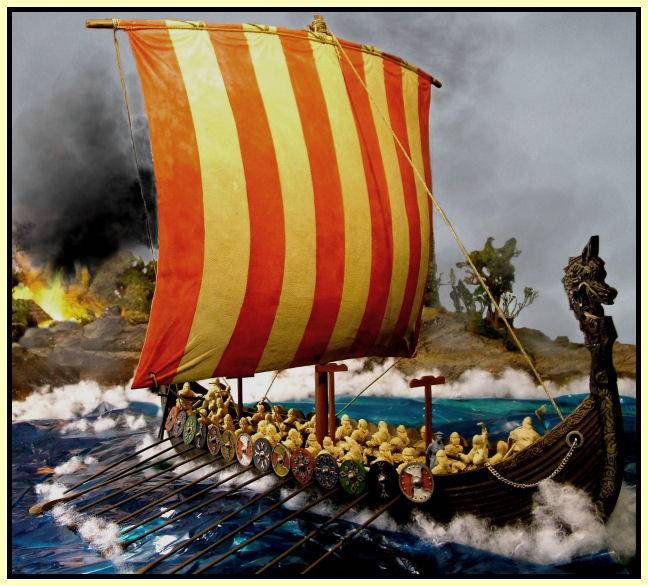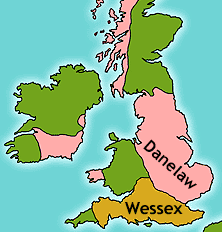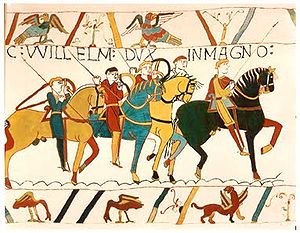
 |
|
|
|
Back to the Anglo Saxon Survival Guide Index |
|
Overview: Who were the Anglo SaxonsThe Anglo Saxon Era lasted from about 449 to 1066. Much of the England we know today dates back to these years. Our language, our places names, many of our laws and traditions owe much to this period.
If you ask the question: Who were the Anglo Saxons? The answer is WE ARE! Did you know? The name Anglo-Saxon comes from two of the tribes who invaded Britain - The Angles and the Saxons.
The Anglo Saxon Invasion
AD 449: In their days Hengest and Horsa,
From AD 70 until around AD 400 to 416 most of Britain was ruled from Rome as the Province of Britannia. As pressures from outside the empire, and weaknesses and corruption from inside grew Rome abandoned Britain. The result was that the Romano-British (who would one day become the Welsh) were left to defend themselves from Picts and Irish and Germanic Raiders.
The Anglo-Saxon Chronicle and other records suggest that after Rome officially told the former province of Britannia to look to its own defences in about 416 AD that the British invited in Germanic mercenaries to help defend Britain. Probably German tribes were already migrating to Britain in the Roman period as the Romans used Germans in their Legions but in 449 there is this entry. The British King Vortigern invited Hengest and Horsa to come to Britain.
Hengest and Horsa were followed by many other warlords and their followers. At first they fought for the British and settled peacefully along the eastern and Southern coasts. Eventually several things may have occured: 1. Its possible that the British refused to pay the mercenaries or to give them promised land. 2. The numbers of Anglo-Saxons grew year on year and in time their immigration became a big problem bringing them into conflict with the Romano-British Population. 3. Ambitious Warlords amongst the newcomers saw an opportunity to carve out a kingdom and launched attacks. 4.Pressures from movement of Eastern Europeans westwards pushed the Angles and Saxons off their own homelands encouraging them to look elsewhere for land.
However it happened by the late 5th centuries colonies and settlements of many tens to hundreds of thousands of Anglo Saxons were established. The stage was set for several centuries of conflict that would see the Anglo-Saxons occupy most of what is today England.
The invading TribesThere were a number of Tribes who migrated to Britain:
The Angles - from Denmark settled along the North and East - in Northumbria and East Anglia. The Saxons - from Northern Germany settled Essex, Sussex, Kent and other South Eastern parts. The Jutes from the north of Denmark landed along the south coast especially around Hampshire. There were other tribes who came such as the Frisians from Holland and the Franks (who also invaded and gave their name to France).
These tribes were divided and fought as much against each other as against the Romano-British inhabitants. Indeed in the early period there were several times when the British and allies launched huge counter attacks such as at Catraeth in circa AD 597 and Degsastan in AD 603. The Anglo-Saxons weathered these storms and by the mid 7th Century had established a number of strong Kingdoms.
The Heptarchy
After the first few centuries the myriad of colonies and settlements had merged into what is usually identified as seven more permanent kingdoms. These were the kingdoms of Northumbria, Mercia, East Anglia, Essex, Kent, Sussex and Wessex. The Roman-British were now pushed west into Wales, Cornwall, the Scotish Borders, Lancashire and Cumbria. This process of amalgamation into these larger kingdoms was ongoing but by about AD 800 this is what England looked like:
The Overlords - or ImperatorsFrom about AD 600 onwards several of the Chroniclers of the time began to talk of overlords or Imperators who recalling the power of Roman Emperors exerted influence BEYOND their own borders. In the late sixth century the King of Kent was a prominent lord in the south; in the seventh century the rulers of Northumbria and Wessex were powerful; in the eighth century Mercia achieved hegemony over the other surviving kingdoms. These Imperators give us a hint of the struggle towards the possibility of a single King and a single Kingdom - England. But just as the move towards a unified England are going on the we enter the era of a great threat to England - the Vikings.
The Viking InvasionsAD 787 to 1066
A.D. 787 . This year King Bertric took Edburga the daughter of
From the late 8th century and in particular the 9th,10th and 11th Centuries the Vikings or Danes began raiding Britain. At first the Vikings plundered and killed but went away again. In time, however, they stayed and settled the east coast of Northumbria and East Anglia. They destroyed the Kingdoms of Northumbria, East Anglia, Essex and Mercia and almost overran Wessex. But a young king called Alfred defeated them at Edington, Wiltshire, in 878 and earned himself the name "The Great". He made a peace with the Vikings and saved England but the peace deal granted the VIkings a kingdom called Danelaw which included their possession of Jorvik (York) and so the Danes had gained a solid foothold in England.
The Vikings would continue to be a threat right up to 1066 when they fought Harold at Stamford Bridge. Indeed a Viking King - Canute and his sons sat on the English throne in the 11th century and ruled over a unified England at last - Vikings and English as one people.
This unified England carried on under the last Anglo Saxon Kings - Edward and Harold. Finally then we have one land - one England. Then came 1066.
1066 - The end
King Edward the Confessor made one major error. Having failed to produce an heir he made a mess of establishing the sucession. He led William of Normandy into a belief that he was the heir - a belief given weight when William obliged the obvious English candidate - the powerful Earl Harold - to swear alliegance to him. When Edward died and the Witan elected Harold as king the scene was set for the Norman Invasion.
The Norman conquest of England began on 28 September 1066 with the invasion of England by William, Duke of Normandy, who became known as William the Conqueror after his victory at the Battle of Hastings on 14 October 1066, defeating the then king Harold II of England. Harold's army was badly depleted in the English victory at the Battle of Stamford Bridge in Northern England on 25 September 1066 over the army of King Harald III of Norway. By early 1071, William had secured control of most of England, although rebellions and resistance continued to approximately 1088.
The Aftermath - did the Anglo-Saxons Survive?
The Norman conquest destroyed the Anglo-Saxon monarchy and a large part of the noble lines as incoming Normans became the lords of the land. That said the blood line of the Anglo-Saxon kings re-emerged later on because of marriages of various daughters and sons of former kings into for example the Scotish Royal line. So in time the Kings of England would one again have Anglo-Saxon ancestors.
The Normans became the ruling class but probably 95% of the population was English. Although for a time the language used in court was French and that in legal documents latin eventually English reemerges as the dominant language.
Some place names come from the Norman period but most come from Anglo-Saxon and Viking origins. Many of the laws we have have origins in the Anglo-Saxon common law.
So we can conclude that the Anglo-Saxon period did not really end in 1066. If you are English or of English decent YOU ARE an Anglo-Saxon.
|
|
|
|
